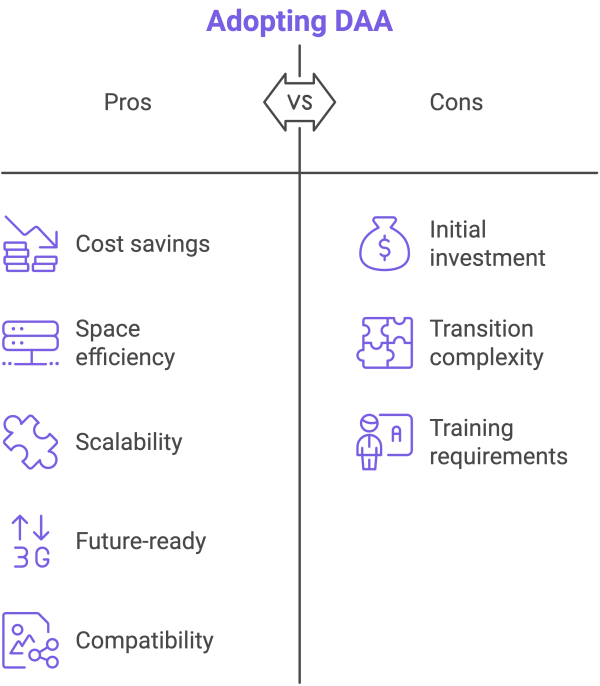As we head into the 10G future, Distributed Access Architecture (DAA) is becoming the answer to network scaling and service delivery challenges. An umbrella term associated with several technologies, DAA changes cable networks by moving functions traditionally located in the headend or hub closer to the subscriber, optimizing bandwidth and maximizing network flexibility. It has become a prerequisite for DOCSIS 4.0.
The Evolution of DAA
Announced in a series of specifications initially released by CableLabs in 2015, the elements of DAA overcome constraints of the more centralized, legacy DOCSIS architecture. By distributing key network functions and extending the digital domain to the fiber-optic node, DAA boosts network efficiency and performance.
The transformation is significant. Moving the digital-to-RF interface to the fiber-coaxial boundary boosts available bandwidth, increases fiber efficiency and reach, leads to better signal quality and reduces the demand for power and space. These benefits are enabling multiple system operators (MSOs) to deliver faster and more reliable connectivity in dense areas where the HFC network is being asked to carry more and more traffic.
At a high level, DAA splits DOCSIS network functions into a Media Access Control (MAC) layer responsible for devices gaining access to the network, and a Physical (PHY) layer that handles the transmission and reception of data. As originally conceived, DAA enabled the partial or full removal of these components from the headend or hub via Remote (R)-CCAP, Remote (R)-MAC-PHY, and Remote (R)-PHY.
Of these, R-MAC-PHY and R-PHY have endured to serve somewhat different market segments. While R-MAC-PHY has certain advantages for tier 2 and tier 3 operators, R-PHY has become the most prevalent approach to date, delivering DAA’s benefits while aligning well with existing infrastructure, and DOCSIS 3.1 and 4.0 standards and incremental deployment options.
DAA Benefits and Trends
Let’s look more closely at DAA’s benefits and deployment trends. First, to meet the growing demands for speed and reliability, DAA delivers several leading benefits:
- Better Network Performance: By replacing analog optical links with digital Ethernet, DAA improves signal-to-noise ratios, resulting in clearer and more reliable connections and less signal loss over distance.
- Cost and Space Efficiency: DAA reduces power and in the headend space by up to 90 percent compared to traditional architectures, resulting in big cost savings.
- Scalability: The modular approach allows operators to add capacity incrementally, making it easier to future-ready the network.
- Aligned with 10G Goal: DAA is compatible with digital optics and necessary for DOCSIS 4.0, with its 10 Gbps potential; MSOs can adapt their infrastructure accordingly as subscriber demand and technology evolve.
In market terms, DAA is picking up speed. In mid 2024, the research firm Dell’Oro Group estimated a 15 percent increase in overall cable outside plant equipment expenditures, driven in part by DAA projects. “The current focus on Remote PHY and band splitting will lead to longer-term DOCSIS 4.0 upgrades, particularly in the North American market and select European markets, where operators are looking to increase capacity and keep pace with fiber ISPs,” said Dell’Oro VP Jeff Heynen.
Leading players like Comcast, Cox, Charter and Vodafone are setting the pace for DAA deployments. The market will grow as more operators commit to 10G and beyond.
Challenges and Considerations
While DAA has its benefits, implementing it raises several considerations for MSOs:
- Operational Complexity: Decentralizing functions may simplify life at the headend and hub, but it requires specialized expertise in the outside plant and new maintenance protocols for field upgrades.
- Interoperability: Integrating hardware and software from multiple vendors is a challenge. Ensuring compatibility is part of CableLabs’s mission, but MSOs must conduct their own tests to ensure system-wide performance consistency.
- Network Readiness: Evaluating the existing network for DAA readiness is crucial. This means looking at fiber dispersion, jitter and other characteristics to ensure the network can support decentralized functions without performance degradation.
Ready for the 10G Future
DAA is critical to the cable industry’s future. By optimizing existing HFC infrastructure and supporting both the Extended Spectrum DOCSIS (ESD) and Full-Duplex (FDX) DOCSIS versions of DOCSIS 4.0, DAA allows operators to deliver faster, more reliable and more scalable broadband services. As MSOs roll out DAA, they’re laying the groundwork for next-gen connectivity and keeping pace with fiber networks and subscriber demand.
With DAA, MSOs are future-readying their networks and preparing for the high-speed, low-latency demands of 10G. As DAA adoption grows, it will become the launchpad for the next round of cable network success.
To learn more about how DOCSIS 4.0 can give MSOs a competitive advantage, see the blog post here.
Other Resources from AOI
eBook: Guide to DOCSIS 4.0
Quantum18 | 1.8GHz HFC Amplifiers
QuantumLink | Remote Management